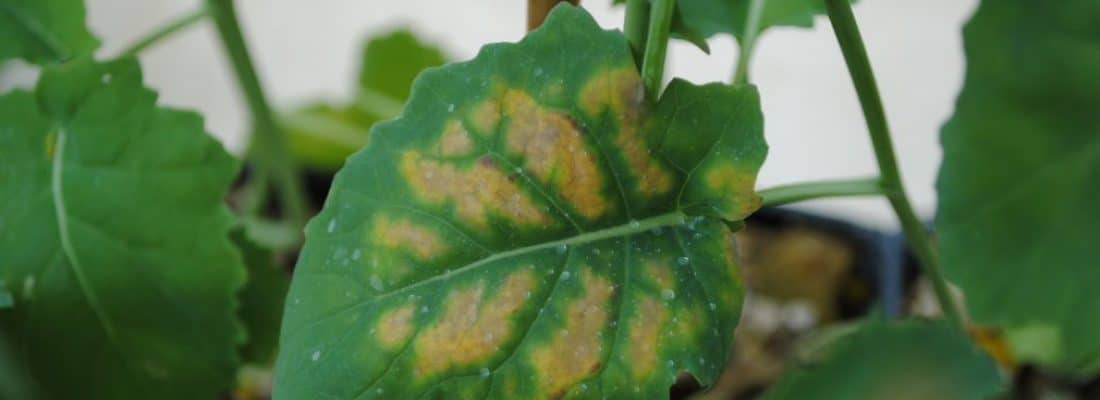Canola requires 14 essential nutrients, which are classified as macronutrients (nitrogen, phosphorus, potassium and sulfur, magnesium and calcium) or micronutrients (iron, manganese, zinc, copper, boron, molybdenum, chlorine and nickel), based on the relative amounts needed by the plant. Macronutrients are needed in large amounts relative to micronutrients.
Important tips for best management
- The best return on fertilizer investment for canola comes from nitrogen, phosphorus and sulphur. For nutrients other than these, deficiencies that cause noticeable yield reduction can happen, but are rare.
- In situations where deficiency of these secondary nutrients or micronutrients is suspected, apply fertilizer to a small affected area and mark it clearly. Visual observations combined with final yield measurements from the treated and untreated areas should help determine if a measurable response occurred, and can help determine your approach to that micronutrient in future years.
Calcium (Ca)
Calcium is a macronutrient absorbed in relatively large amounts by canola. However, deficiencies in western Canada are rare due to ample soil reserves. Calcium is often referred to as a secondary nutrient, probably due to uncommon deficiencies and non-specific roles in the plant.
Calcium supply for canola
Canola has high demand for calcium. Canola needs Calcium at about double the level of sulphur and phosphorus, but deficiencies in western Canada are rare due to ample soil reserves. Also, only 10 per cent of plant Calcium ends up in canola seed. The rest is returned to the field in crop biomass. This is why Ca, while needed in large amounts, is considered a secondary nutrient.
Role of calcium in canola plants
Calcium performs several roles in the plant. In contrast to other macronutrients, a high proportion of calcium is found as a structural component in cell walls. Calcium’s structural function is to provide stable but reversible molecular linkages. Pectins are calcium compounds in cell walls that strengthen the wall and contribute to tissue resistance against fungal and bacterial infections. Calcium also plays a fundamental role in membrane stability and maintains cell integrity. This membrane protection is important under low temperature or saturated soil stress. Calcium bound at membrane surfaces can be exchanged with other cations (such as K+, Na+ and H+). Calcium exchange with sodium at membrane surfaces is a main factor in salinity stress. Also, calcium replacement with aluminum (Al+3) (or blocking of calcium channels) is a factor in aluminum toxicity in acid soil.
Cell extension requires calcium. Rapidly growing parts are, therefore, most affected by calcium deficiency. Root extension, shoot elongation and pollen growth are dependent on adequate calcium. The secretion of mucilage by root caps (that help root tips penetrate through soil) also needs calcium. Downward root growth (gravitropic response) relies on adequate calcium in the root caps. Callose formation is another example of a process involving calcium. In response to injury, cells will produce callose instead of cellulose, which helps wounds to heal and reduce infection.
Most plant calcium is present in leaf vacuoles where it likely contributes to the cation-anion balance. Calcium also stimulates a range of enzymes, but generally is not a constituent of enzymes. Calcium plays a key role in plants as a secondary messenger in turgor regulated processes such as stomata opening and closing.
Response of canola to applied calcium
Western Canada has relatively new soils, and calcium levels are still very high. For example, of the 863 canola tissue samples ALS labs tested for calcium deficiency in 2012, only one was below 0.4 per cent. Calcium deficiency tends to be more common in older, more weathered soils that have been farmed for much longer and are exposed (no snow cover) more months of the year.
Calcium uptake by canola
Canola roots mainly absorb calcium as the Ca+2 cationA positively-charged ion (ion with a net positive charge). More dissolved in the soil water. Plant available calcium also exists as exchangeable calcium adsorbed on soil organic matter, silt and clay surfaces. The amount of dissolved calcium depends on the amount of calcium-containing minerals, the soil cationA positively-charged ion (ion with a net positive charge). More exchange capacity and soil pH.
Calcium fertilization is not necessary for canola production on the majority of soils in western Canada.
The table below shows exchangeable and extractable calcium reserves in Western Canadian soils. These levels are considered well above deficiency levels, but in fact there is no good criteria to determine the connection between soil calcium levels and deficiency.
Table 8. A survey of calcium levels of 1,220 western Canadian soils
Source: Karamanos et al. 2001.
In western Canada, responses to calcium have been reported in the Peace River Region and East Central Alberta and are associated with soils of high sodium content.
High pH soils (greater than 7.5) usually contain the highest calcium due to significant amounts of precipitated calcium salts (lime and gypsum).
Since calcium is absorbed out of the soil water, the dominant processes controlling the supply to roots are mass flow, diffusion and root interception. Therefore, calcium availability is dependent on adequate soil moisture.
Unusual situations that can create calcium deficiency in canola in western Canada are Solonetzic soils (sodium induced calcium deficiency), acidic soils (hydrogen or aluminum-induced calcium deficiency), and waterlogged soils (restricted root uptake of calcium inducing temporary calcium deficiency).
The calcium content varies between different plant parts and ages, ranging from 0.2 per cent to five per cent. The highest calcium contents are found in old leaves. At maturity, only about 10 per cent of plant calcium is found in the canola seed.
Situations that produce the greatest chance of a response
Calcium deficiency is possible in:
- strongly acidic soils
- strongly alkaline non-saline soils; These soils contain high exchangeable sodium levels and have a high pH.
- sandy soils with very low organic matter levels, low CEC and high oxide content
- soils from parent materials high in serpentine (i.e. contain disproportionately high magnesium content)
- saturated soils can cause temporary calcium deficiency, but in this case calcium fertilizer will not help. Excess soil moisture can make it difficult for canola plants to take up nutrients, and in some cases, calcium deficiencies showed up more vividly than other deficiencies. This is likely due to crop growth stage and the timing or duration of the flooding. Cell extension requires calcium. Rapidly growing parts are, therefore, most affected by calcium deficiency. In this case, the best course of action would be to wait until the soil dries up and the crop starts growing again. Symptoms can correct themselves.
Identifying deficiencies
Calcium deficiency symptoms include:
- A condition where the stem goes flat and flops over, typically just below the growing point (bud or flower cluster) at the top of stems and branches. It is referred to as “ribbon stem.”
- Accelerated maturity. The plant will set seed quickly, sometimes locking in low yield.
- Yellowing, browning and necrosisA symptom of plant cell or plant tissue death. More (tissue dies) in patches in the middle of leaves. This is actually a unique symptom of calcium deficiency.
- Dark spots on pods which turn brown and necroticA symptom of plant cell or plant tissue death. More.
A soil test can provide soil calcium levels, but no soil criteria have been established to show at what level soils are considered calcium-deficient for canola.
A tissue test may show plants are deficient in calcium, but calcium may be in the soil at adequate rates, the plant just can’t access it because of saturated soils. A rescue application of calcium will not help in this case. Plants often recover after soils dry out.
The cationA positively-charged ion (ion with a net positive charge). More exchange capacity (CEC) is a measure of a soil’s ability to hold on to key positively charged nutrients, such as calcium, magnesium and potassium, and keep them close for when the crop needs them. In western Canada, soils with high clay and high organic matter tend to have a high CEC, so these soils are more likely to have an adequate supply of these nutrients on hand. A CEC of one milligram of hydrogen equivalent (meq) per 100 grams of soil is very low. CEC is ideally between 10 and 30 meq per 100 grams. To calculate CEC on a soil, take the soil’s percentage of clay and multiply by 0.5, then take the percent organic matter and multiply by two. Then add these two numbers to get CEC.
Fertilizer sources and methods of application
Calcium nitrate or calcium sulphate are the most common calcium fertilizer products.
Calcium carbonate (CaCO3 or limestone), or calcium oxide (CaO or lime) is used to raise the pH on acid soils. It can also have the added benefit of increasing soil calcium content, but is not generally recommended as a calcium treatment in soils that don’t need pH adjustment.
Foliar, dribble band liquid formulations are on the market from various sources and in various blends, often including a mix of micro- and macronutrients. This is a better application method than seed applied for a macronutrient such as calcium as it allows for rates sufficient to correct deficiencies.
Research in Alberta and by the Canola Council of Canada in 2000 using seed treatment with Ca5S did not find a response in canola at nine locations.
Magnesium (Mg)
Of all the macronutrients, magnesium is absorbed in the least amount by plants. Magnesium deficiencies are rare on the prairies, similar to calcium. However, magnesium has more specific roles in plant function than calcium.
Table 9. Plant tissue analysis interpretative criteria for canola (whole above ground plant at flowering)
Role of magnesium in canola plants
Magnesium is the central atom of the chlorophyll molecule, and depending on the magnesium sufficiency level, up to 25 per cent of the total plant magnesium is bound to chlorophyll. Magnesium is also needed for protein synthesis, and to activate many enzymes such as glutathione synthase, carboxylases, phosphatases, and ATPases. Most of the plant magnesium is contained in cell vacuoles where it serves as a reserve for the metabolic pool and contributes to cation-anion balance.
Characteristics of magnesium uptake by canola
Magnesium uptake by canola is very similar to that of calcium. The plant available form is the Mg+2 cationA positively-charged ion (ion with a net positive charge). More that exists in the soil solution and as exchangeable magnesium adsorbed on soil organic matter, silt and clay surfaces. The amount of dissolved and exchangeable magnesium will depend on the extent of magnesium containing minerals, soil pH and cationA positively-charged ion (ion with a net positive charge). More exchange capacity.
Table 10. A survey of magnesium levels of 1,220 western Canadian soils
Source: Karamanos et al. 2001. Unpublished data.
Soils slightly acidic to neutral in pH tend to have the highest available magnesium levels. This is due to magnesium being a weak competitor for exchange sites on soil colloids and root binding sites. At higher pH and in soils with free lime, Ca+2 will dominate the exchange sites, possibly inducing magnesium deficiency. In contrast, at low pH, hydrogen (H+), aluminum (Al+3) and manganese (Mn+2) under flooded conditions, will dominate the exchange sites, inducing magnesium (and calcium) deficiency. High potassium (K+) or ammonium (NH4+) levels in the root zone due to fertilization may also induce magnesium deficiency, although it is often short term. High magnesium levels relative to calcium can induce a calcium deficiency. This has been reported in barley grown on solonetzic soil in Alberta with high magnesium: calcium ratios.
Magnesium level is highest during early vegetative growth (about 0.5 per cent), and declines with maturity. Stems and roots contain the least magnesium. At harvest, straw magnesium level is less than 0.2 per cent while canola seed contains about 0.3 per cent magnesium. Roughly 1/3 to ½ of the above ground magnesium is contained in the seed (about seven or eight kilograms per hectare or six or seven pounds per acre).
Of the macronutrients, magnesium is absorbed in the least amount. Magnesium deficiencies are rare on the Prairies, similar to calcium.
Little information exists on magnesium requirements of canola. There are no known cases of canola response to magnesium fertilizer in Canada or Europe. Therefore, no reliable soil or canola tissue test criteria exist. However, magnesium deficiency appears unlikely in slightly acidic to neutral soils that do not have excessive amounts of root zone calcium, potassium or ammonium.
If magnesium deficiency were to occur, it would be more likely in soils with:
- higher pH and free lime. In these soils, calcium (Ca+2) will dominate the exchange sites, possibly inducing magnesium deficiency.
- low pH. At low pH, hydrogen (H+), aluminum (Al+3) and manganese (Mn+2) under flooded conditions, will dominate the exchange sites, inducing magnesium (and calcium) deficiencies.
- high potassium or ammonium levels in the root zone due to fertilization. Magnesium deficiency in this situation would likely be short term.
Identifying deficiencies
Actual photos of symptoms on canola are lacking due to the rarity of actual in field deficiencies. However general symptom descriptions suggest interveinal or blotchy chlorosis or necrosisA symptom of plant cell or plant tissue death. More on older leaves as most likely.
Fertilizer sources and methods of application
Magnesium sulphate is the most common magnesium fertilizer source.
Potassium magnesium sulphate, which is sold as K-Mag, is a dry fertilizer product containing 21-22 per cent potassium, 10-11 per cent magnesium and 21-22 per cent sulphur.
Table 11. Tissue test levels for micronutrients in canola: at flowering, in parts per million (ppm)
Source: Alberta Agriculture and Rural Development and Manitoba Provincial Soil Testing Laboratory



